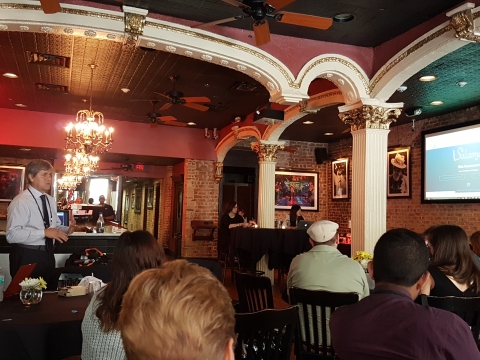
At the Investigative Reporters & Editors (IRE) conference this past weekend, journalists, news developers and technologists gathered in New Orleans for four days of sessions on investigative journalism in all its forms.
Amid this atmosphere of shared learning, exchange of ideas and collaboration, the ICFJ Knight International Journalism Fellowships program hosted another Steal My Tool event and luncheon during the conference.
Ahead of the event, IJNet and ICFJ Knight compiled 10 free, open source investigative tools created by ICFJ Knight Fellows here.
Here’s a look at the eight tools demoed during the event that can be adapted in your newsroom:
Robert Gebeloff, database projects editor at The New York Times, demonstrated how to use XML Grid to access and interpret a website’s data. Using these tools and techniques, Gebeloff showed how one can find which Trader Joe’s stores sell beer by simply scraping the site’s XML code. Gebeloff has published detailed instructions for web scraping without programming on his GitHub page.
Amanda Strydom, managing editor of the African Network of Centers for Investigative Reporting (ANCIR), showcased Siyazana, which reveals financial connections between South Africa’s private and public spheres, allowing for easier investigation and heightened transparency. Siyazana is built from Grano, a mapping tool for illustrating political and economic influence. You can steal Siyazana’s code on GitHub and adapt it for your own country here.
Mike Tigas, news applications developer at ProPublica, offered up Tabula and Onion Browser. Tabula extracts data from PDF documents into a CSV or Microsoft Excel spreadsheet. The tool has been used in investigative reporting projects at ProPublica, Argentina’s La Nación, The New York Times and more. Its code can be forked on GitHub here. Onion Browser is a web browser for iOS that allows users to browse the web anonymously by tunneling it through the Tor onion router network. Steal Onion Browser’s code here.
My @ICFJKnight #IRE16 #StealMyTool links:https://t.co/EaAQANhtRzhttps://t.co/XAQ2CjW7Vvhttps://t.co/kb4la3g3Huhttps://t.co/mpSlX932da
— Mike Tigas (@mtigas) June 17, 2016
ICFJ Knight Fellow Jorge Luis Sierra talked Salama, the risk assessment app he built for journalists working in dangerous environments. Using Salama, it’s possible for journalists and news organizations to determine their level of risk; once this happens, Salama connects them with security resources that fit their risk level. Salama’s code can be found here.
DocumentCloud’s Ted Han showed off his tool, a repository of primary source documents for journalists, researchers and activists. Using DocumentCloud Pages, it’s possible to responsively embed these documents within stories and on websites. It has been used by outlets like BuzzFeed and The Chicago Tribune, and played a role in a Pulitzer-winning investigative piece. Han demoed DocumentCloud at the first Steal My Tool event during the NICAR conference, as well. Its GitHub can be found here.
David Lemayian, lead technologist at Code for Africa, introduced sourceAFRICA, a repository for more than 21,000 actionable documents and data from across Africa. ANCIR developed sourceAFRICA from DocumentCloud’s code, adapting it to serve as a catalog for African documents with the potential to spur societal change. Code for Africa itself has developed more than 90 open source projects, all of which can be hacked on its GitHub page.
After "stealing" @documentcloud's code, @DavidLemayian + @Code4Africa helped improve DocumentCloud in return #StealMyTool #IRE16
— IJNet (@IJNet) June 17, 2016
Troy Thibodeaux, interactive newsroom technology editor at The Associated Press, demoed Geomancer. The tool allows journalists to instantly mash up data based on shared geography, a task that normally requires several steps. Hack Geomancer’s code on GitHub here.
Miranda Patrucic, reporter and editor for OCCRP, discussed the Investigative Dashboard — a platform that helps investigative journalists more easily do their job. It consists of search engines, databases, a research support system and a file manager, making it a one-stop shop for journalists looking to investigate an issue. The GitHub page for its search feature can be found here.
This post was also published on IJNet, which is produced by ICFJ.
Main image of Jorge Luis Sierra taken by David Lemayian.